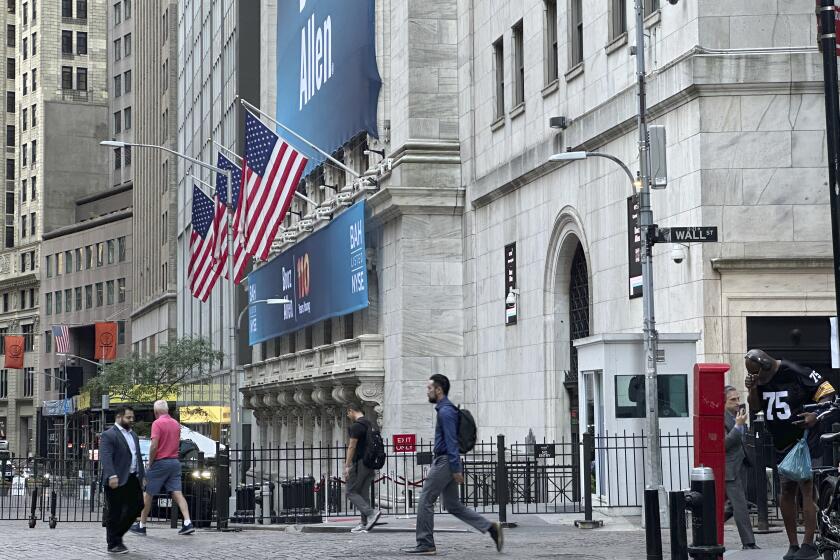Column: 5G will be the next revolution in global communications, but the U.S. may be left behind
- Share via
In late 2017, Susan Crawford was visiting Seoul, South Korea, about six months before it hosted the 2018 Winter Olympics.
Although she’s an expert in telecommunications policy, Crawford was stunned at what she witnessed in Korea, which she describes as “the most wired nation on the planet” — flawless cellphone coverage even in rural areas, real-time data transmission, driverless buses using the latest communications technology to smoothly avoid pedestrians and evade obstructions.
“I’ve never been embarrassed to be American before,” Crawford told me recently. “But when Korean people tell you that going to America is like taking a rural vacation, it really makes you stop and worry about what we’re up to.”
Crawford, who teaches at Harvard Law School, has assembled her concerns, along with suggestions for how to alleviate them, in a new book published this week entitled “Fiber: The Coming Tech Revolution — and Why America Might Miss It.” It’s a follow-up to her 2013 book “Captive Audience,” which warned that the nation’s global leadership in internet technology was being frittered away by placing tech policy in the hands of profit-seeking companies with no incentive to keep the U.S. on the leading edge.
It may sound paradoxical, but the future of advanced wireless services depends completely on how much fiber is in place.
— Susan Crawford
“Fiber” describes how that trend has intensified. The risk is even greater today, Crawford writes, because the data-carrying capacity of the next generation of fiber optics, known as “5G” (as the fifth generation of wireless telecommunications technology), will give countries that invest in those advanced networks a huge advantage over those that don’t. It’s 100 times faster than the existing 4G technology and far more capacious, allowing simultaneous connections of billions of devices.
Which countries are investing in the technology? For one, China, which is planning to cover 80% of its residences and businesses with 5G connectivity by 2025. “While the leaders of the USA and China rant and rave at one another, Western companies continue to work closely with those in China, aware that 5G will be a global platform,” observed tech analysts at ReThink Research last month. “In the run-up to 5G, it has been China’s operators, especially China Mobile, which have been a driving force.”
As Crawford reports, America’s experience with trying to bring fiber to its homes and businesses isn’t auspicious. Only about 10% of the nation’s 119 million households subscribe to high-speed fiber services, and 75% of census blocks have no access to residential fiber at all. Households with fiber connections tend to be located in the most densely developed and richest parts of the country — America’s “digital divide” has turned into a chasm.
This has happened, Crawford writes, because the U.S. hasn’t turned the building of its optical fiber infrastructure into a national imperative — that is, government-supervised — as it did its highways, airports, dams and bridges. She draws comparisons to the government initiative to bring electrification to rural communities in the 1920s and 1930s.
Electrification, she writes, “followed a set pattern: municipal buildings and businesses first, wealthy urban dwellers next, then poorer urban dwellers, and last of all, rural homes and farms.” That commercial model resulted in 90% of farmers in the 1930s lacking electric power and even poorer sections of thriving cities lacking applicances we take for granted — refrigerators, electric cooking and heating. One result was the rise of public power systems, just as one result of the spotty rollout of fiber connectivity today is the emergence of municipal broadband.
By ceding telecommunications infrastructure to big, monopolistic carriers such as Comcast, Verizon and AT&T, the U.S. government has effectively given up its role in information technology policy, Crawford says. The Federal Communications Commission — under President Obama as well as President Trump — allowed the companies to develop vertically integrated systems in which they own the distribution systems as well as the content moving over those systems; Comcast owns NBC Universal, AT&T owns Time Warner properties including CNN and Warner Bros., and Verizon owns Huffington Post, Yahoo, and other former AOL properties.
“These guys’ plans will be to have islands of exclusive content,” Crawford told me. “You will join the Comcast world when you’re born, or the AT&T world.”
That control removes the incentive for the internet carriers to spend much to upgrade their distribution networks to fiber, she argues. “They’re looking for ways to make more money out of the same physical infrastructure, not for ways to expand that infrastructure. They feel they’ve reached the number of people they want to serve, and now they’re just looking for how to make more money from them.”
That’s a critical problem, because although 5G networks serve wireless devices, they still need extensive land-based fiber systems —in fact, much more extensive systems than the existing 4G technology. “It may sound paradoxical,” Crawford writes, “but the future of advanced wireless services depends completely on how much fiber is in place.” At the moment, there’s not enough of it in the U.S. to meet the needs of 5G, and the big private companies will not and can not raise the private capital needed to build more, at least not from investors looking for a quick return on their money. Basic infrastructure “requires patient capital,” Crawford observes.
The answer is to bring in the only entities willing to make long-term, patient investments: cities, states and the federal government, the same entities that built dams, roads and bridges — indeed, the internet itself — before it was clear how any of that infrastructure could be exploited by private companies for profit.
Cities and localities can guarantee bonds to provide low-cost financing for fiber networks; the federal government can exploit its own rock-bottom borrowing costs. All have the incentive to bring the networks to residents and businesses shunned by the commercial internet carriers because they don’t look sufficiently profitable.
But the incumbent internet firms are standing in the way, Crawford reports. The companies have been pushing state legislation and federal regulations that would give them more power to decide how to deploy 5G equipment in their own interest by cutting local and state authorities out of the process. California Gov. Jerry Brown vetoed one such bill in 2017, in a decision regarded as a blow to the major wireless internet carriers.
Crawford believes it’s pointless to expect any leadership on this issue from the current FCC or its Republican chairman, Ajit Pai. “Today’s FCC is the equivalent of a loading dock up to which the incumbents’ trucks are backing to take out as much cash as they can. There’s no thought of genuine oversight of the current market.”
The solution may be to track what happened with electrification a century ago — start small. “There are 700 communities and cooperatives across the country, many of them in Republican areas, that deeply understand this issue and are pragmatically working on building fiber networks. Just as with electricity, you start on the local level and gradually shame the feds into doing something.”
The problem, however, is that people without genuine high-speed connections don’t know what they’re missing, so they aren’t clamoring for improvement — yet. “There’s a little bit of internet access in a lot of places, and a lot of confusion over what it would mean to have a world-class connection. In America, people just don’t know.”
Keep up to date with Michael Hiltzik. Follow @hiltzikm on Twitter, see his Facebook page, or email [email protected].
Return to Michael Hiltzik’s blog.







